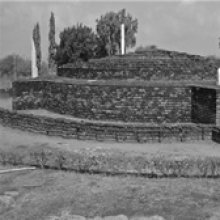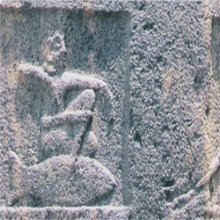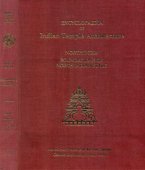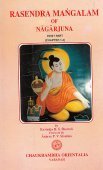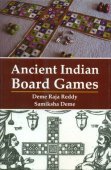Andhra, Āndhra, Amdhra: 22 definitions
Introduction:
Andhra means something in Buddhism, Pali, Hinduism, Sanskrit, Jainism, Prakrit, the history of ancient India. If you want to know the exact meaning, history, etymology or English translation of this term then check out the descriptions on this page. Add your comment or reference to a book if you want to contribute to this summary article.
Images (photo gallery)
(+17 more images available)
In Hinduism
Purana and Itihasa (epic history)
Source: Wisdom Library: Varāha-purāṇaAndhra (अन्ध्र).—One of the seven sons of Dyutimān, who was a son of Priyavrata, according to the Varāhapurāṇa chapter 74. Priyavrata was a son of Svāyambhuva Manu, who was created by Brahmā, who was in turn created by Nārāyaṇa, the unknowable all-pervasive primordial being.
Source: archive.org: Puranic Encyclopedia1) Andhra (अन्ध्र).—(ĀNDHRA). This is the Andhra Pradesh in modern India. It has to be surmised that this place was very famous during the period of the composition of the Mahābhārata. (Mahābhārata, Bhīṣma Parva, Chapter 9, Verse 49).
2) Andhra (अन्ध्र).—Warriors from Andhra were called Andhras. (Mahābhārata, Droṇa Parva, Chapter 4, Verse 8).
3) Āndhra (आन्ध्र).—The present Āndhra Pradeśa. It was famous even from purāṇic times and it was annexed by Sahadeva by defeating its ruler in a game of dice.
Source: Cologne Digital Sanskrit Dictionaries: The Purana Index1a) Andhra (अन्ध्र).—Born of Dīrghatamas and Bali's wife. (Burnouf's reading—Oḍra).*
- * Bhāgavata-purāṇa, IX. 23. 5.
1b) The son of Dṛṣadaśva (Vṛṣadaśva, Vāyu-purāṇa).*
- * Brahmāṇḍa-purāṇa III. 63. 27; Vāyu-purāṇa 88. 26.
1c) —(c)—a Janapada under the Devarakṣitas.*
- * Vāyu-purāṇa 99. 385; Viṣṇu-purāṇa IV. 24. 64.
1d) A people of the southern country ruled for 300 years;1 a sinful tribe got purified by praying to Hari;2 defeated by Bharata.3 See āṇdhras.4
- 1) Bhāgavata-purāṇa, XII. 1. 22; Vāyu-purāṇa 45. 127; 47. 44; 78. 69; 99. 268, 361.
- 2) Bhāgavata-purāṇa II. 4. 18.
- 3) Ib. IX. 20. 30.
- 4) Matsya-purāṇa 50. 76.
2a) Āndhra (आन्ध्र).—The kings of Andhra dynasty, thirty in number, ruled the earth for 456 years. Seven of them were contemporaries of seven Kauśalas, chiefs of Vidūra and Niṣadhas;1 According to matsya purāṇa, 19 members of the dynasty ruled for 460 years. Kingdoms of ārya and Mleccha existed side by side—Ābhīras, Gardabhilas, Śakas, Yavanas, Tuṣāras, Guruṇḍas, and Hūṇas.2
2b) A tribe purified by the worship of Hari.1 Enlisted by Jarāsandha against the Yadus;2 a southern country unfit for performing śrāddha.3
- 1) Bhāgavata-purāṇa II. 4. 18.
- 2) Bhāgavata-purāṇa X. [50 (V) 3].
- 3) Brahmāṇḍa-purāṇa II. 16. 59; III. 14. 80; IV. 29. 131.
Āndhra (आन्ध्र) refers to an ancient country which should be shunned, according to the 10th century Saurapurāṇa: one of the various Upapurāṇas depicting Śaivism.—It looks upon Kurukṣetra, Matsya, Pāñcāla and Surasena as holy countries where Dharma is practiced. It advises people to shun Aṅga, Vaṅga, Kaliṅga, Surāṣṭra, Gurjara, Ābhira, Kauṅkaṇa, Draviḍa, Dakṣiṇāpatha, Āndhra and Magadha.—(cf. verses 17.54-59) Thus it appears that this Purāṇa was written somewhere about the north-western part of northern India.

The Purana (पुराण, purāṇas) refers to Sanskrit literature preserving ancient India’s vast cultural history, including historical legends, religious ceremonies, various arts and sciences. The eighteen mahapuranas total over 400,000 shlokas (metrical couplets) and date to at least several centuries BCE.
Natyashastra (theatrics and dramaturgy)
Source: Wisdom Library: Nāṭya-śāstraAndhra (अन्ध्र) is the name of a country situated within the Dākṣiṇāpatha (Deccan) region. Countries within this region pertain to the Dākṣinātyā local usage (pravṛtti) according to the Nāṭyaśāstra chapter 14. These pravṛttis provide information regarding costumes, languages, and manners in different countries of the world. It is mentioned this region lies between the Southern Ocean and the Vindhya mountains.
The Andhras are usually to be represented by a brown (asita) color when painting the limbs (aṅgaracanā), according to Nāṭyaśāstra chapter 23. The painting is a component of nepathya (costumes and make-up) and is to be done in accordance with the science of āhāryābhinaya (extraneous representation).

Natyashastra (नाट्यशास्त्र, nāṭyaśāstra) refers to both the ancient Indian tradition (shastra) of performing arts, (natya—theatrics, drama, dance, music), as well as the name of a Sanskrit work dealing with these subjects. It also teaches the rules for composing Dramatic plays (nataka), construction and performance of Theater, and Poetic works (kavya).
Kavya (poetry)
Source: Shodhganga: The Kavyamimamsa of RajasekharaAndhra (अन्ध्र) is the name a locality mentioned in Rājaśekhara’s 10th-century Kāvyamīmāṃsā.—The country Andhra lying between the river Godāvari in the north side and the Kṛṣṇa in the south side. Its capital name was Pratiṣthanapura.

Kavya (काव्य, kavya) refers to Sanskrit poetry, a popular ancient Indian tradition of literature. There have been many Sanskrit poets over the ages, hailing from ancient India and beyond. This topic includes mahakavya, or ‘epic poetry’ and natya, or ‘dramatic poetry’.
Shaktism (Shakta philosophy)
Source: Google Books: ManthanabhairavatantramAndhra (अन्ध्र) or Andhranātha is the name of the Siddha associated with the sacred seat of Kāmarūpa, according to the Manthānabhairavatantra, a vast sprawling work that belongs to a corpus of Tantric texts concerned with the worship of the goddess Kubjikā.

Shakta (शाक्त, śākta) or Shaktism (śāktism) represents a tradition of Hinduism where the Goddess (Devi) is revered and worshipped. Shakta literature includes a range of scriptures, including various Agamas and Tantras, although its roots may be traced back to the Vedas.
Jyotisha (astronomy and astrology)
Source: Wisdom Library: Brihat Samhita by VarahamihiraAndhra (अन्ध्र) [=Āṇḍhra] refers to a country belonging to “Āgneyī (south-eastern division)” classified under the constellations of Āśleṣā, Maghā and Pūrvaphālguni, according to the system of Kūrmavibhāga, according to the Bṛhatsaṃhitā (chapter 14), an encyclopedic Sanskrit work written by Varāhamihira mainly focusing on the science of ancient Indian astronomy astronomy (Jyotiṣa).—Accordingly, “The countries of the Earth beginning from the centre of Bhāratavarṣa and going round the east, south-east, south, etc., are divided into 9 divisions corresponding to the 27 lunar asterisms at the rate of 3 for each division and beginning from Kṛttikā. The constellations of Āśleṣā, Maghā and Pūrvaphālguni represent the south-eastern division consisting of [i.e., Andhra] [...]”.

Jyotisha (ज्योतिष, jyotiṣa or jyotish) refers to ‘astronomy’ or “Vedic astrology” and represents the fifth of the six Vedangas (additional sciences to be studied along with the Vedas). Jyotisha concerns itself with the study and prediction of the movements of celestial bodies, in order to calculate the auspicious time for rituals and ceremonies.
In Buddhism
Mahayana (major branch of Buddhism)
Source: Wisdom Library: Maha Prajnaparamita SastraAndhra (अन्ध्र) or Andhradeśa is the name of a territority mentioned as one of the “low places of birth”, which represents one of the five dreadful things mentioned in the 2nd century Mahāprajñāpāramitāśāstra chapter XL.1.4. Accordingly, “in regard to Buddha’s mundane qualities (laukikaguṇa), no one is able to attain them because he has rooted out dreadful things at their very roots. These dreadful things are: (2) a low place of birth (nīcajāti-sthāna), for example: Ngan-t’o-lo (Andhra)”.
The (Andhra) territory included between the Godāvari basin and the Kistna basin, occupied by people of Dravidian race and of Telugu language and called Andhradeśa nowadays. According to the sources mentioned above (Preface to vol. I, p. xii seq.), Nāgārjuna, the presumed author of the Traité, lived part of his life in Andhra at Śrīparvata, and had friendly relations with the Śatavāhana or even the Ikṣvākus who reigned over the region in the 2nd and 3rd century C.E. In that case, it is hard to see why the writer of the Traité shows so much scorn for Andhradeśa by putting it at the top of the list of bad places to be born.

Mahayana (महायान, mahāyāna) is a major branch of Buddhism focusing on the path of a Bodhisattva (spiritual aspirants/ enlightened beings). Extant literature is vast and primarely composed in the Sanskrit language. There are many sūtras of which some of the earliest are the various Prajñāpāramitā sūtras.
In Jainism
General definition (in Jainism)
Source: archive.org: TrisastisalakapurusacaritraAndhra (अन्ध्र) is the name of an ancient country, according to chapter 2.4 [ajitanātha-caritra] of Hemacandra’s 11th century Triṣaṣṭiśalākāpuruṣacaritra: an ancient Sanskrit epic poem narrating the history and legends of sixty-three illustrious persons in Jainism.
Accordingly:—“'Then the King set out following the path of the cakra-jewel to the west, obscuring the sun by the dust of the army. [...]; blinding the Andhras by his own splendor like the sun blinding owls; [...] the King gradually arrived at the shore of the western ocean. After he had established camp, concentrating on Prabhāsa, observing a three days’ fast, he began pauṣadha in the pauṣadha-house. [...]”.

Jainism is an Indian religion of Dharma whose doctrine revolves around harmlessness (ahimsa) towards every living being. The two major branches (Digambara and Svetambara) of Jainism stimulate self-control (or, shramana, ‘self-reliance’) and spiritual development through a path of peace for the soul to progess to the ultimate goal.
India history and geography
Source: Singhi Jain Series: Ratnaprabha-suri’s Kuvalayamala-katha (history)Āndhra (आन्ध्र) is classified as one of the eighteen dialects (Deśī) of ancient India, as described in the Kathās (narrative poems) such as Uddyotanasūri in his 8th-century Kuvalayamālā (a Prakrit Campū, similar to Kāvya poetry).—Page 152.24 ff.: Here we have a specimen of eighteen Deśī dialects spoken in: [e.g., Āndhra] [...] These different idioms of speech were spoken by the shop-keepers in the market place of Vijayāpurī. [...]

The history of India traces the identification of countries, villages, towns and other regions of India, as well as mythology, zoology, royal dynasties, rulers, tribes, local festivities and traditions and regional languages. Ancient India enjoyed religious freedom and encourages the path of Dharma, a concept common to Buddhism, Hinduism, and Jainism.
Languages of India and abroad
Sanskrit dictionary
Source: DDSA: The practical Sanskrit-English dictionaryAndhra (अन्ध्र).—(pl.)
1) Name of a people and the country inhabited by them. [The country of the Āndhras is said to be the modern Telingana. But the limits were probably confined to the Ghats on the West and the rivers Godāvarī and Krisnā on the North and South. It bordered on Kalinga (See Dk. 7th Ullāsa), and its capital Andhranagara is probably the old town of Vengi or Vegi. According to Daṇḍin, there was near it a lake 'like the ocean and crested with cranes' which description can only refer to the lake Colair which has an area of over 15 miles; जगन्नाथाटूर्ध्वभागाद- र्वाक् श्रीभ्रमरात्मकात् । तावदन्ध्राभिधो देशः (jagannāthāṭūrdhvabhāgāda- rvāk śrībhramarātmakāt | tāvadandhrābhidho deśaḥ)].
2) Name of a dynasty of kings.
3) A man of a mixed (low) caste, being born of a Vaideha father and Kārāvara mother, who lives by killing game; कारावरो निषादात्तु चर्मकारः प्रसूयते । वैदेहकादन्ध्रमेदौ बहिर्ग्रामप्रतिश्रयौ (kārāvaro niṣādāttu carmakāraḥ prasūyate | vaidehakādandhramedau bahirgrāmapratiśrayau) || Manusmṛti 1.36.
4) A kind of fowler.
Derivable forms: andhraḥ (अन्ध्रः).
--- OR ---
Āndhra (आन्ध्र).—a. Belonging to Āndhra (as language).
-dhraḥ (pl.) The Telagu country, modern Telangana; see अन्ध्र (andhra).
-ndhrī An Āndhra wife.
Source: Cologne Digital Sanskrit Dictionaries: Shabda-Sagara Sanskrit-English DictionaryĀndhra (आन्ध्र).—m.
(-ndhraḥ) A native of Telengana. E. andhra country, aṇ aff.
Source: Cologne Digital Sanskrit Dictionaries: Benfey Sanskrit-English DictionaryAndhra (अन्ध्र).—m. 1. The name of a people. 2. A man of a low caste, son of a Vaidca by a Kārāvara woman, [Mānavadharmaśāstra] 10, 36.
Source: Cologne Digital Sanskrit Dictionaries: Cappeller Sanskrit-English DictionaryAndhra (अन्ध्र).—[masculine] [Name] of a people and of a caste.
Source: Cologne Digital Sanskrit Dictionaries: Monier-Williams Sanskrit-English Dictionary1) Andhra (अन्ध्र):—m. Name of a people (probably modern Telingana)
2) of a dynasty
3) a man of a low caste (the offspring of a Vaideha father and Kārāvara mother, who lives by killing game), [Manu-smṛti x, 36.]
4) Āndhra (आन्ध्र):—mf(ī)n. ([from] andhra), belonging to the Andhra people
5) m. the Andhra country
6) a king of that country
7) m. [plural] the inhabitants of that country, [Mahābhārata; Bhāgavata-purāṇa etc.]
Source: Cologne Digital Sanskrit Dictionaries: Goldstücker Sanskrit-English DictionaryAndhra (अन्ध्र):—1. m. pl.
(-ndhrāḥ) 1) The name of a people or country in the Dekhan, probably the northern part of the modern Telingana. Comp. āndhra.
2) The name of a dynasty; see andhrabhṛtya. 2. m.
(-ndhraḥ) A man of low caste: the offspring of a Vaideha father and a Kārāvara mother; he lives by killing game and is not allowed to reside within a village or town, but must live under Chaitya-trees, in cemeteries, on mountains or in forests; (according to Manu, who embodies in this manner the Andhra-aborigines into the Brahmanical system). Compare also āndhra. E. unknown.
Source: Cologne Digital Sanskrit Dictionaries: Yates Sanskrit-English Dictionary1) Andhra (अन्ध्र):—(ndhraḥ) 1. m. A hunter.
2) Āndhra (आन्ध्र):—(ndhaḥ) 1. m. A Telinga man.
Source: DDSA: Paia-sadda-mahannavo; a comprehensive Prakrit Hindi dictionary (S)Āndhra (आन्ध्र) in the Sanskrit language is related to the Prakrit word: Aṃdha.
[Sanskrit to German]
Sanskrit, also spelled संस्कृतम् (saṃskṛtam), is an ancient language of India commonly seen as the grandmother of the Indo-European language family (even English!). Closely allied with Prakrit and Pali, Sanskrit is more exhaustive in both grammar and terms and has the most extensive collection of literature in the world, greatly surpassing its sister-languages Greek and Latin.
Kannada-English dictionary
Source: Alar: Kannada-English corpusĀṃdhra (ಆಂಧ್ರ):—
1) [noun] one of the Dravidian language chiefly spoken in, and the official language of, Andhra Pradesh and Telangana.
2) [noun] one of the southern states of Republic India (earlier including the present Telengana.
3) [noun] a male member of a people living in that state or whose mother tongue is Telugu.
Kannada is a Dravidian language (as opposed to the Indo-European language family) mainly spoken in the southwestern region of India.
See also (Relevant definitions)
Starts with: Andhra Yunivarsiti, Andhra-danda, Andhra-mahabharatam, Andhrabhrita, Andhrabhritya, Andhradesha, Andhrajati, Andhrajatiya, Andhraka, Andhranatha, Andhrapatha, Andhrashabdacintamani, Andhratika, Andhravaka, Andhrayati.
Ends with (+47): Abandhra, Adiamdhra, Agrarandhra, Ajaramdhra, Alarandhra, Anekarandhra, Anyatahsitirandhra, Aparandhra, Arandhra, Aukshnorandhra, Bagh-jandhra, Bandhra, Bhirurandhra, Bhritarandhra, Brahmarandhra, Galarandhra, Griharandhra, Gudhapatraramdhra, Guptapatraramdhra, Jalamdhra.
Full-text (+480): Andhrabhritya, Andha, Amdhra, Andhrajati, Andhri, Andhraka, Antirar, Andhrajatiya, Vengi, Andhradesha, Skandasvati, Kadapa, Rajanna, Hala, Godavari, Shrishaila, Gautamiputra, Dravida, Andhapura, Krishna.
Relevant text
Search found 88 books and stories containing Andhra, Āndhra, Amdhra, Āṃdhra; (plurals include: Andhras, Āndhras, Amdhras, Āṃdhras). You can also click to the full overview containing English textual excerpts. Below are direct links for the most relevant articles:
Andhra Culture, A Synthesis < [April 1952]
The Andhra Demand < [October 1938]
The Andhra State: Problems and Potentialities < [July 1953]
The Matsya Purana (critical study) (by Kushal Kalita)
Part 2.2g - The Andhra Dynasty < [Chapter 3 - Historical aspects in the Matsyapurāṇa]
Part 3 - Date of the Matsyapurāṇa < [Chapter 1 - Introduction]
Part 2 - Genealogy of Kings and Princes in the Matsyapurāṇa < [Chapter 3 - Historical aspects in the Matsyapurāṇa]
The Bhagavata Purana (by G. V. Tagare)
Chapter 1 - Dynasties of the Kali Age < [Book 12 - Twelfth Skandha]
Chapter 4 - Creation of the Universe (Prayers to Hari) < [Book 2 - Second Skandha]
Chapter 23 - The History of the Dynasties of Anu, Druhyu, Turvasu and Yadu < [Book 9 - Ninth Skandha]
The history of Andhra country (1000 AD - 1500 AD) (by Yashoda Devi)
Part 24 - Visvesvara (A D. 1377-1407) and Choda Ganga (A.D. 1391-1417) < [Chapter XI - The Chalukyas]
Part 3 - Gonka II (A.D. 1137—1161-62) < [Chapter I - The Velanandu Chodas of Tsandavole (A.D. 1020-1286)]
Puranic encyclopaedia (by Vettam Mani)
Vastu-shastra (5): Temple Architecture (by D. N. Shukla)
Chapter 4 - Prāsāda styles (C): Vesara
Stūpas (Shrines for Devotion) < [Chapter 12 - History of Hindu Temples (Prāsādas and Vimānas)]
Temple architecture in Ceylon (Sri Lanka) < [Chapter 12 - History of Hindu Temples (Prāsādas and Vimānas)]
Related products
(+3 more products available)
